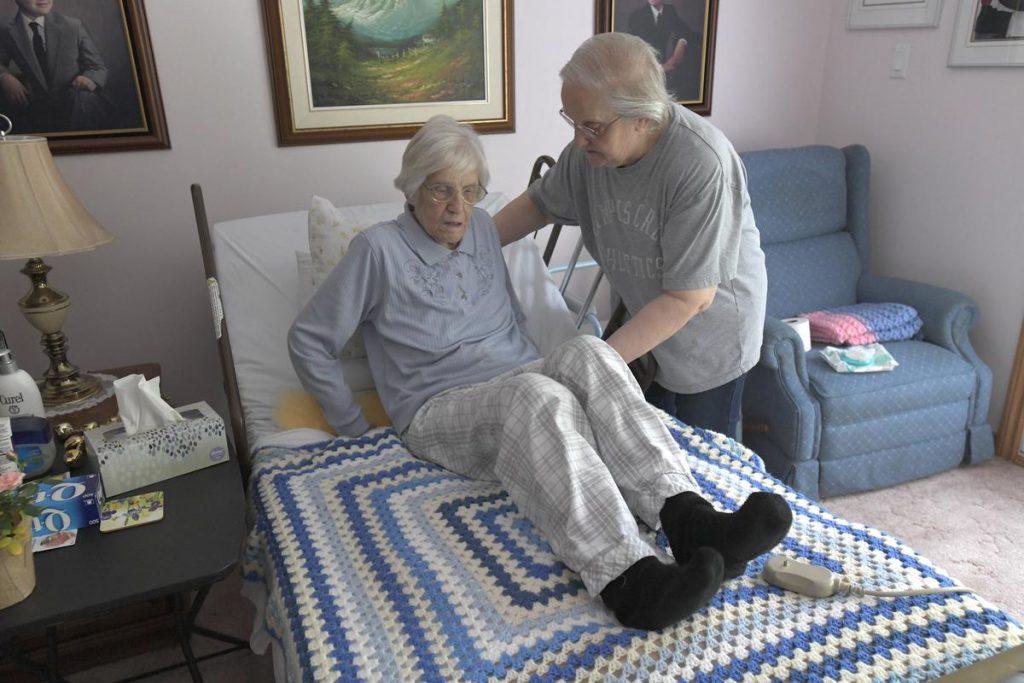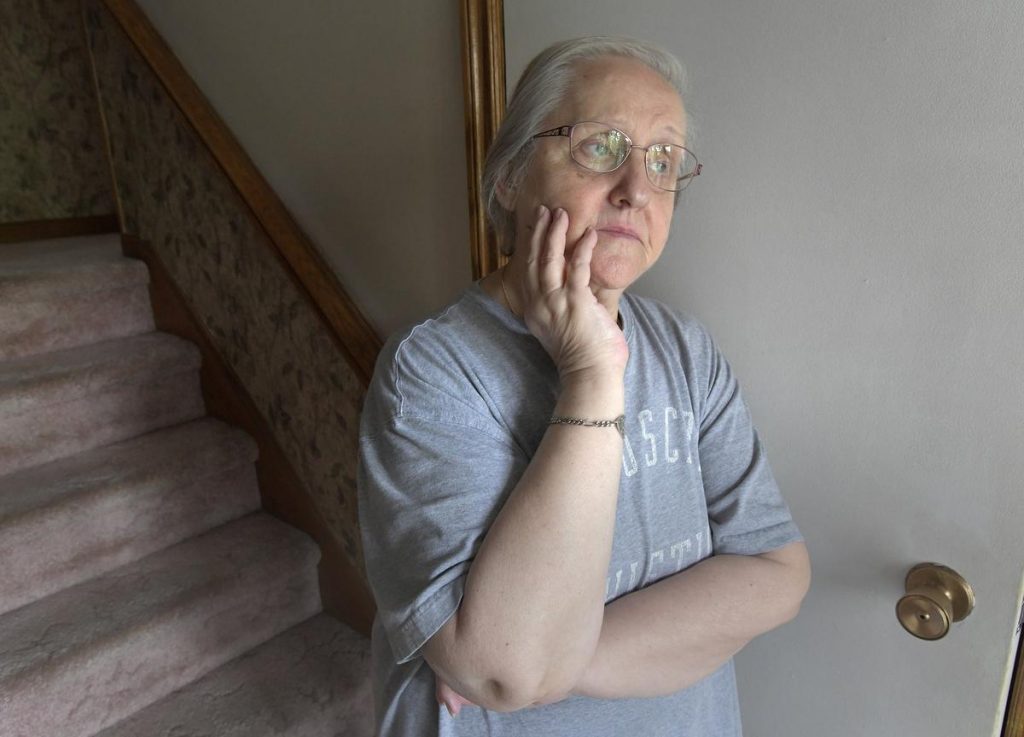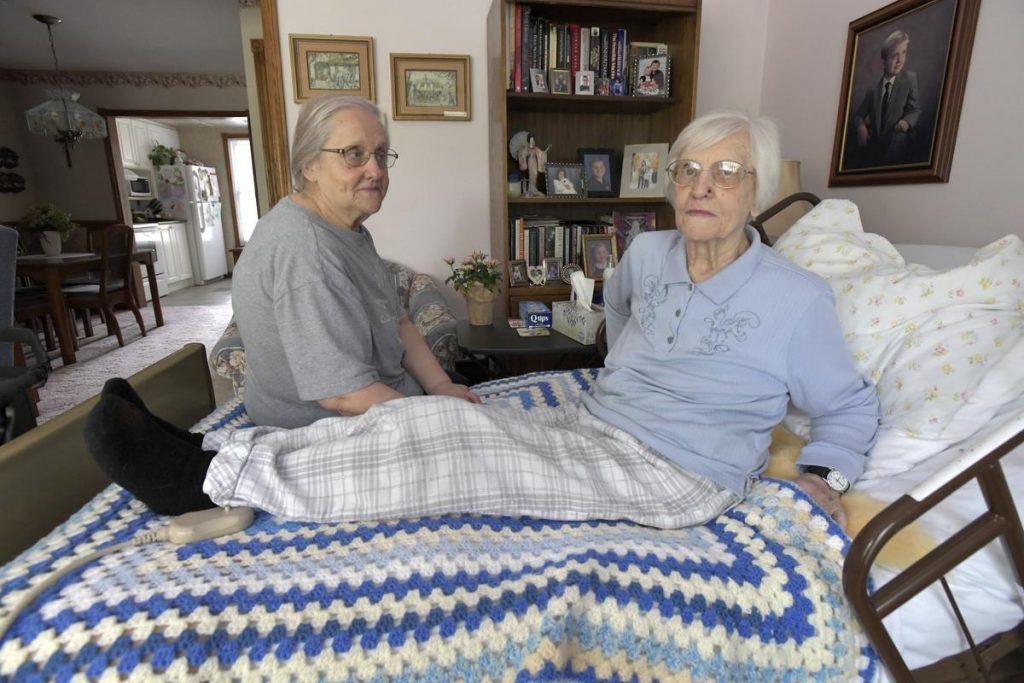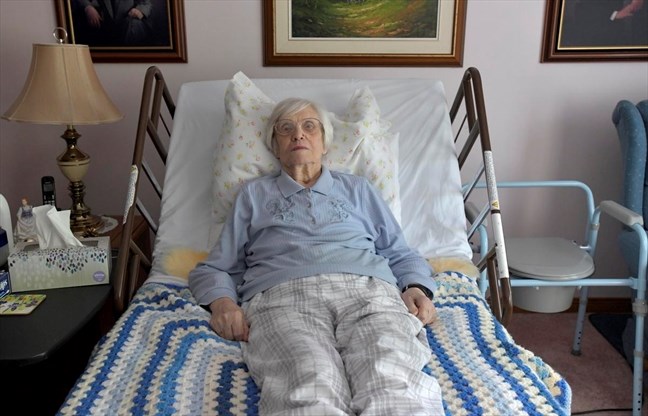The model of bundled care sees different groups of providers band together, share accountability and care for the patient throughout the entire journey.
July 24, 2019 By Joanna Frketich , Grant LaFleche
The Hamilton Spectator and St. Catharines Standard

HAMILTON, ON- JUNE 17- Susan Apro helps her mother Pat Coffer, 94, into bed in Apro’s livingroom where Coffer spends 18-20 hours a day sleeping. Coffer was relatively healthy – gardening and walking – until she started having heart issues in April . It’s hard to guess what the journey of patients like Pat Coffer will look like after the Progressive Conservative’s massive health-care restructuring, but the goal is for it to resemble bundled care. bundled care attempts to bridge the gaps that often leave patients lost by never handing the patient off from one service to another, making life for people like 94-year-old Pat Coffer, a little bit easier. June 17, 2019. John Rennison/The Spectator
Something as simple as a phone number has made it doable for Susan Apro to care for her 94-year-old mother at home.
Those 10 digits mean help from St. Joseph’s Healthcare is just a call away for the 70-year-old daughter who is taking on the daunting task of caregiver after her fiercely independent mom, Pat Coffer, developed untreatable heart issues and an aneurysm in April that has left her severely debilitated.
“It means the world to me,” said Apro. “For mom to come home, the burden has all fallen on me … I don’t know what the heck I’m doing.”
The trusted voice on the other end of the line can send a nurse or personal support worker to the East-Hamilton house outside of the usual home-care schedule. Another day, Apro could be asked to send a picture of an emerging bed sore to get instructions on what to do.
“I didn’t have to scramble to get anyone to come into the home,” said Apro. “We can call this number any time.”
Never having to navigate the health-care system alone is the foundation of the highly successful pilot program called bundled care or integrated comprehensive care, introduced by St. Joseph’s in 2012.
“My mom made me promise that she would never go in a nursing home, so as long as I’m able, I’ll keep my mom home, looking after her,” said Apro. “With this program, I have that support behind me.”
It’s hard to guess what a patient’s journey will look like after the Progressive Conservative’s massive health-care restructuring, but the goal is for it to resemble bundled care.
“It is a highly respected model that this plan mimics,” says Donna Skelly, Conservative MPP for Flamborough—Glanbrook. “It has been very successful in Hamilton. It’s a model that we are, in essence, replicating with this new approach to health-care delivery.”
The health-system revamp came into effect June 6 under the Connecting Care Act. An investigation by The St. Catharines Standard and The Hamilton Spectator provides the most comprehensive coverage to date of the overhaul, considered the biggest change since Medicare.
The plan, announced in February, puts a super agency named Ontario Health in charge of the entire health-care system — from hospitals to community care to organ donation to cancer care. It will oversee dozens of regional groups, called Ontario Health Teams, made up primarily of health and social service organizations working together to integrate services locally and help area residents navigate the system.
As the Conservatives undo many of the previous governments’ health-care reforms, primarily local health integration networks (LHINS), there is some irony that a program championed by the Liberals is the prototype for the latest round of health-care restructuring.
Similar to the planned Ontario Health Teams, the bundled care model sees different groups of providers band together, share accountability and care for the patient through the entire journey. There is one pot of money split between all the services, increased use of technology and a navigator to guide patients’ through the system.
“Even family docs have trouble navigating the system,” said Dr. Tom Stewart, CEO of St. Joseph’s and Niagara Health. “We need to make it easier.”
Stewart himself admits he was worried when his father’s lung cancer surgery was scheduled on a Friday at the Hamilton hospital he now leads.
“You’re always a little nervous sending people home on Friday because you’re not sure their home-care team is going to show,” he said. “There is not that point of accountability. It’s a fragmented system.”
Bundled care attempts to bridge the gaps that often leave patients lost by never handing the patient off from one service to another.
Planning starts at admission — or even before for scheduled procedures — so services needed, both in and out of hospital, are pre-arranged and ready to go when needed.
Discharge is not when the patient leaves the hospital but roughly 60 days after going home with one team of providers responsible for the patient’s care from start to finish. The team could include doctors, nurses, physiotherapists, occupational therapists, social workers, dietitians, respiratory therapists, speech and language pathologists and personal support workers. Ideally, the patient meets as much of the team as possible before leaving the hospital.
Most important, there is one point of contact called a care co-ordinator who arranges what’s needed, oversees the care and helps the patient navigate the system.
“We would refer and set up all their services at home,” said Heather Paterson, Niagara Health’s chief nursing officer and director of patient care. “Our care co-ordinator follows (the patient) from hospital to home.”
Patients get a number to call 24-7 where co-ordinators are on standby to stick handle any issues.
Members of the team, such as specialists, can be accessed through technology, which is the type of “virtual visit” recommended by the Premier’s Council on Improving Health Care and Ending Hallway Medicine in its June report as a way to cope with the increasing demands of an aging population.
Stewart’s dad was able to get immediate answers from his doctors without leaving home when there were potential issues with his surgical wound.
“I’m a doctor, and I would have quite honestly said, ‘Go back to emerg,'” said Stewart. “He ends up calling a number and sending a picture of the wound from home with technology, and the doctors say, ‘This is normal. Don’t worry about it.’ That prevents an emerg admission, so you can see how you can start to improve the system.”
Stewart says the program’s three major pillars are one multidisciplinary team, one medical record and one number for patients to call.
The program now stretches from Niagara to Kitchener and has expanded to include chronic lung disease, congestive heart failure, lung cancer surgery, hip and knee replacements, peritoneal dialysis and mental health and addictions. In the fiscal year that started April 1, it is expected to expand to all patients undergoing planned and scheduled surgeries at St. Joseph’s.
So far, 17,000 area patients have received bundled care. Its success was highlighted by the Premier’s Council. Its June report states the program reduced length of hospital stay by 1.26 days on average, reduced costs within 30 days by $2,110 and within 90 days by $3,035.
In addition, 87 per cent of surveyed patients said they felt they were involved and informed in their care.
“The vast majority are saying it’s way better,” said Stewart. “The health-care workers are happier and home-care workers are telling us they feel they can get a nurse or doctor at the hospital easier now, and they feel part of the same team. Caregivers, the patients and their families are a lot more happy.”
St. Joseph’s reports up to a 30-per-cent reduction in emergency visits and hospital readmission rates
At Niagara Health, the readmission rate has fallen to 15 per cent from 19 per cent three years ago, when the program started. The number of patients having to visit the emergency room after discharge also fell over the same period to 32 per cent from 38 per cent.
“By offering the support and building capacity in the community, we are able to manage patients and give them access to care they might not have had,” Paterson said.
It was a lifeline for Apro after her active mom went from gardening and walking to spending most of her time in bed.
She wouldn’t have known where to turn if the program hadn’t arranged for a hospital bed, walker and commode chair to be sent to her house so her mom could live on the main floor. Making it more difficult is that Coffer hasn’t had a family doctor since hers retired.
“My mom has never been sick, and all of a sudden, she’s got these heart issues and she can’t even wash herself,” said Apro. “It’s very upsetting, and it’s a lot of work to take on, but I wouldn’t let anyone else do it.”
The program isn’t perfect. Its major weakness is primary care isn’t involved at all, leaving patients vulnerable after discharge from bundled care.
“There’s got to be that hand off,” said Dr. David Price, head of family medicine at McMaster University. “If you don’t integrate that then they fall through the cracks.”
Bundled care is also too narrow in scope, says Rob MacIsaac president and CEO of Hamilton Health Sciences.
“From my perspective, it doesn’t make a lot of sense to limit it to certain patient populations that are defined by their illnesses,” he said. “I think it would be much better if we could open it up.”
Under Ontario Health Teams, this model would significantly expand to eventually cover all patients and not just those transitioning from hospital to home.
“It will improve patient care by connecting care,” Health Minister Christine Elliott said on a July 18 conference call with health care workers. “People are discharged from hospital, and those people feel like they are shut out of their own health care system and have to fight their way back in.”
She said patients need to know their after-hospital care will continue at home, know how that care works and when and how they can access it.
Even the CEO of the regional network being dismantled by the restructuring thinks patients will be better off in the end.
“While we know these proposed changes will take time, when fully realized, patients, families and caregivers will have access to faster, better and more co-ordinated services,” said Donna Cripps, CEO of the Hamilton Niagara Haldimand Brant LHIN, which includes Burlington.

HAMILTON, ON- JUNE 17- Susan Apro has her mother Pat Coffer, 94, living in her livingroom where Coffer spends 18-20 hours a day sleeping. Coffer was relatively healthy – gardening and walking – until she started having heart issues in April . June 17, 2019. John Rennison/The Spectator
It is expected to take years before the monumental changes envisioned by the Conservatives are in place.
“You just can’t change a system as big as health care on a dime,” said Paul Johnson, who is representing the city in the Hamilton Ontario Health Team application.
The government also has to be careful not to disrupt care during the changes.
“It has a lot of promise but, in the meantime, there are going to be things that have to be done to keep the health system functioning while facing some very serious challenges,” said Anthony Dale, president and CEO of the Ontario Hospital Association.
The Ontario Health Coalition worries those pressing issues, like overcrowded hospitals, inadequate home care and shortages of long-term care, will fall by the wayside during the overhaul.
“The whole attention of the health-care system now has turned to restructuring and will be for years,” said executive director Natalie Mehra. “I fear for how long it is going to take to go through all of this.”
It’s expected the health-care changes will happen so gradually that patients won’t ever see a big bang where suddenly the health-care system is turned on its head.
“You won’t notice much of a difference in the first week or month or even the first six months,” said Price. “I hope when we look back in three to five years, we will see difference.”
For the most part, patients will continue to interact with the health-system as normal.
“The message we’re communicating … is business as usual,” said Dr. Ralph Meyer, vice-president of oncology and palliative care at HHS and regional vice-president of Cancer Care Ontario. “We’ll evolve as the system evolves.”
The LHIN says its continuing to do the same work it has always done, even as its board has been dismantled and back-office jobs eliminated.
“Home and community care continues as before, and there are no changes to the long-term care home placement,” said Cripps. “People can continue to contact their home- and community-care providers as normal to access the care they need.”
The Canadian Union of Public Employees (CUPE) says the slow change will be hard for health-care workers, particularly in sectors where their roles are expected to dramatically shift.
“For the people who work for the LHINs, nobody knows really what will happen to them,” said Michael Hurley, president of the Ontario Council of Hospital Unions, which is part of CUPE. “They are expected to soldier on; they are not asked for their input, and they are not valued.”

Never having to navigate the health-care system alone is the foundation of the highly successful pilot program called bundled care or integrated comprehensive care, introduced by St. Joseph’s in 2012, which makes it much easier for Susan Apro to care for her mother Pat Coffer. | John Rennison, The Hamilton Spectator
The health-care system is split on how to respond to the changes, with lines drawn between those planning to protest and those hoping to be among the first to adopt the new system.
“We will fight the legislation,” said Mehra. “It’s undemocratic and it’s dangerous.”
The Ontario Health Coalition wants public hearings across the province so Ontarians can have their say.
“The government needs to hear from Ontarians about the real, on-the-ground impacts of what they have created,” said Mehra. “Slow down and listen to people.”
CUPE agrees that the lack of consultation with the public and health-care workers is a top concern.
“I would really appreciate it if this government would stop this process and have a genuine dialogue with people,” said Hurley.
The Ontario Nurses’ Association has started a campaign with the slogan, “Don’t let Doug Ford wreck health care” that urges people to email the premier, the health minister and their MPP.
“This chaotic overhaul of health care is going to take years and cost millions, and there’s no guarantee it will add one single hour of direct care, and it won’t add any of the skilled caregivers who are needed so urgently,” states the campaign.
“The whole attention of the health care system now has turned to restructuring and will be for years. I fear for how long it is going to take to go through all of this,” says Natalie Mehra, the Executive director of Ontario Health Coalition. | Chris Young, The Canadian Press
Unifor had a phone-in town hall for its members about the restructuring and has started a leaflet campaign.
“Wherever we can, we’re going to join in the fight,” said regional director Naureen Rizvi. “People are very angry.
A rally at Queen’s Park April 30 led by the Ontario Health Coalition drew thousands of protesters.
“They’re saying it’s going to be a streamlined system, but I don’t see how they’ve put a model together that actually achieves that,” said Andrea Horwath, Hamilton Centre MPP and leader of the NDP.
On the flip side, Niagara, Hamilton and Burlington health and social service organizations have applied to be early adoptors of the changes by proposing Ontario Health Teams, which are expected to transform the local system. All three groups were informed July 18 that their proposals are moving to the next stage of application.
“In Hamilton, we are in a really good spot to respond to this call,” said family physician leader Price.
Health leaders see it as a logical extension of work that has been going on for years in this area.
“We think we’re ready in Burlington and that we could move forward quite quickly,” said Eric Vandewall, CEO of Joseph Brant Hospital. “We’ve got a lot of enthusiasm around the table and a lot of support for moving forward.”
The province plans to learn from the first Ontario Health Teams to tweak the restructuring as problems are found.
“We have to be looking at these early adopters” said Sue VanderBent, CEO of Hamilton-based Home Care Ontario. “They’re our little petri dish where we try some things and we watch what happens and we learn from that.”
But the experiment really started in Hamilton, with bundled care spreading out over the years to Niagara, Burlington and all of the acute care hospitals in the LHIN and beyond.
“It made a huge difference for me,” said 93-year-old Helen Greves, who got bundled care in February after being released from the Niagara Health cardiac unit in St. Catharines.
While she was part of the program because of her heart condition, bundled care was able to have the flexibility to also look after an unrelated ankle injury from a fall at her Niagara-on-the-Lake home shortly before she went into hospital that has made going out for medical treatment even more difficult.
“Well, at 93 I qualify as elderly, I think,” said Greves. “So I really needed the help.”

Eric Vandewall, CEO of Joseph Brant, says a Burlington mental health partnership has increased access to a wide variety of providers. “We’ve eliminated the feeling patients have about not knowing where to go and being bounced around.” | John Rennison, The Hamilton Spectator
What will your care look like?
No one knows yet exactly what care will look like after the health-care overhaul, but a number of area programs give a potential glimpse of the future.
Joseph Brant Hospital
A Burlington mental health partnership gives patients one point of access to a wide variety of providers so they don’t have to navigate the services on their own. Instead, they are directed to the agency best able to meet their needs.
“Historically we did not operate together,” said Eric Vandewall, CEO of Joseph Brant. “Patients would not know how to access service, which is the right provider, and things were not always timely.”
A second program for chronic obstructive pulmonary disease provides patients with a phone number to call when they need guidance and help navigating the system.
A group for those recovering from hip- and knee-replacement surgery allows patients to do rehab, which would normally be provided at home alone, in a clinic with other patients instead. It’s cheaper, has better outcomes and higher patient satisfaction because it provides peer support and motivation.
“All of this is really about working differently with our community-care providers,” said Vandewall about the various programs. “We’ve increased access, we’ve eliminated the feeling patients have about not knowing where to go and being bounced around, they have timely support, and we’ve been able to reduce wait times significantly.”
Niagara Emergency Medical Services
Non-urgent ambulance calls are visited by Mobile Integrated Health Response Teams in Niagara to connect them with the care they need in the community without going to the hospital.
The teams, made up of EMS and providers in the community, were highlighted in June by the Premier’s Council on Improving Health Care and Ending Hallway Medicine for reducing transports to the emergency department by six per cent for those feeling generally unwell, five per cent for mental health issues and two per cent for falls.
• • •
Operation health care reform: Your guide to the series
The provincial government is undertaking a sweeping overhaul of the health-care system. The changes came into effect June 6 under the Connecting Care Act.
An investigation by The St. Catharines Standard and The Hamilton Spectator provides comprehensive coverage of the health reforms considered the biggest change since Medicare. A four-day, nine-story series looks into all aspects of the plan.
Under the plan, a super agency called Ontario Health will be in charge of the entire system from hospitals to community care to organ transplants to cancer care. It will also oversee dozens of regional groups named Ontario Health Teams that will align health and social service organizations to work together to integrate services and help patients navigate the system.

